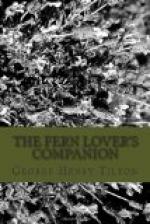A friend unfamiliar with Latin has asked for pointers to aid in pronouncing the scientific names of ferns. Following Gray, Wood, and others we have marked each accented syllable with either the grave (`) or acute () accent, the former showing that the vowel over which it stands has its long sound, while the latter indicates the short or modified sound. Let it be remembered that any syllable with either of these marks over it is the accented syllable, whose sound will be long or short according to the slant of the mark.
We have appropriated from many sources such material as suited our purpose. Our interest in ferns dates back to our college days at Amherst, when we collected our first specimens in a rough, bushy swamp in Hadley. We found here a fine colony of the climbing fern (Lygodium). We recall the slender fronds climbing over the low bushes, unique twiners, charming, indeed, in their native habitat. We have since collected and studied specimens of nearly every New England fern, and have carefully examined most of the other species mentioned in this book. By courtesy of the librarian, Mr. William P. Rich, we have made large use of the famous Davenport herbarium in the Massachusetts Horticultural library, and through the kindness of the daughter, Miss Mary E. Davenport, we have freely consulted the larger unmounted collection of ferns at the Davenport homestead, at Medford,[1] finding here a very large and fine assortment of Botrychiums, including a real B. ternatum from Japan.
[Footnote 1: Recently donated to the Gray Herbarium.]
For numerous facts and suggestions we are indebted to the twenty volumes of the Fern Bulletin, and also to its able editor, Mr. Willard N. Clute. To him we are greatly obligated for the use of photographs and plates, and especially for helpful counsel on many items. We appreciate the helpfulness of the American Fern Journal and its obliging editor, Mr. E.J. Winslow. To our friend, Mr. C.H. Knowlton, our thanks are due for the revision of the checklist and for much helpful advice, and we are grateful to Mr. S.N.F. Sanford, of the Boston Society of Natural History, for numerous courtesies; but more especially to Mr. C.A. Weatherby for his expert and helpful inspection of the entire manuscript.
The illustrations have been carefully selected; many of them from original negatives bequeathed to the author by his friend, Henry Lincoln Clapp, pioneer and chief promoter of school gardens in America. Some have been photographed from the author’s herbarium, and from living ferns. A few are from the choice herbarium of Mr. George E. Davenport, and also a few reprints have been made from fern books, for which due credit is given. The Scott’s spleenwort, on the dedication page, is reprinted from Clute’s “Our Ferns in Their Haunts.”




